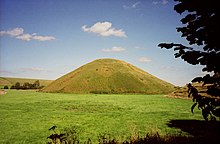Silbury Hill
The Silbury Hill is about 37 m high, 167 m in diameter and a capacity of approximately 248,000 cubic meters of the largest prehistoric artificial mound in Europe and one of the largest in the world. Along with Stonehenge , Avebury and neighboring prehistoric monuments, the hill was added to the UNESCO World Heritage List in 1986 .
location
Silbury Hill is less than 2 miles (driving distance) south of Avebury in the county of Wiltshire in southern England . The monumental stone circle of Stonehenge is about 38 km south.
Dating
The age of Silbury Hill can be dated to an age of around 4400 to 4700 years due to several remains of deer antler poles found on the plateau-like tip , which probably served as tools. The hill is thus the youngest Stone Age monument in the Avebury / Stonehenge area.
Digs
Although there have been at least six known attempts to reveal the purpose of the hill, it is still not fully understood. Richard Atkinson's tunnel excavation clarified the structure of the round hill in 1968–1970. Silbury Hill was built in three stages. The bottom layer consists of peat that has been piled up in a shallow hollow. This was covered with layers of earth, rubble and chalk . Since winged ants were found in the peat , it is believed that the work took place in late July or August - the ants swarm at this time of year.
The first mound was 36 m in diameter and almost doubled in size immediately after completion. The chalk for this was extracted from a 6 m deep pit. This layer was covered with the hill visible today. This third shift was the most extensive construction phase and required sophisticated planning and around six million man- hours of construction time. It increased the diameter of the hill to about 167 m.
The third layer was built from limestone extracted from a pit up to 9 m deep, in several terraces (or in a stepped spiral), each of which was closed off by walls made of chalk. The spaces behind the walls have been filled in with more chalk, as have the edges of the terraces to smooth the hill. Only the top terrace was left. Finds are sparse and consist of a few antler hooks. Moss, pigeon skabios (Scabiosa columbaria) and small meadow button (Sanguisorba minor) were found on plant remains .
In addition to the complex organization of the construction project (planning, transport), the workforce had to be motivated and fed, which requires considerable social complexity and years of high overproduction of food.
In June 2007 extensive construction work was carried out to protect the monument. Further stabilization measures are planned as the hill was destabilized by the earlier investigations. In particular, Atkinson's tunnel was backfilled. The work was completed in April 2008.
interpretation
Although Silbury Hill is reminiscent of an oversized barrow , no human remains or grave goods have been found in it. It is therefore assumed that it never served as a cover for a grave, but must have served other purposes.
Later use
The hill served the Romans as a landmark and the Saxons in the 11th century as a building site for a fortification.
Visitor information
Finds from this excavation area are presented to the public at the Alexander Keiller Museum in Avebury.
See also
literature
- Alastair Whittle: Sacred mound, holy rings: Silbury Hill and the West Kennet Palisade enclosures, a later Neolithic complex in north Wiltshire (Oxford, Oxbow Books 1997). Oxbow monograph 74.
- Homer Sykes: Mysterious Britain - Fact and Folklore George Weidenfeld & Nicolson Ltd. 1993 p. 26
Web links
- Silbury Hill, History - Photos, Info + Links (English Heritage)
- Silbury Hill, History - Photos + Info (Bradshaw Foundation)
- Silbury Hill, history, function etc. - photos, information + links (Ancient Wisdom, English)
Individual evidence
Coordinates: 51 ° 24 ′ 57 " N , 1 ° 51 ′ 27" W.


